Is there anything worse than finding brown spots on your beloved fiddle leaf fig that you take care of do diligently?
If caught early enough and treated urgently, there’s a very good chance your fiddle leaf fig will make a full recovery.
It’s totally understandable that finding unwanted brown spots on your fiddle leaf fig can be a scary thing; that’s why we’ve compiled this helpful list of five causes of brown spots and how to fix it in order to keep your houseplant looking beautiful!
Read on to learn more.
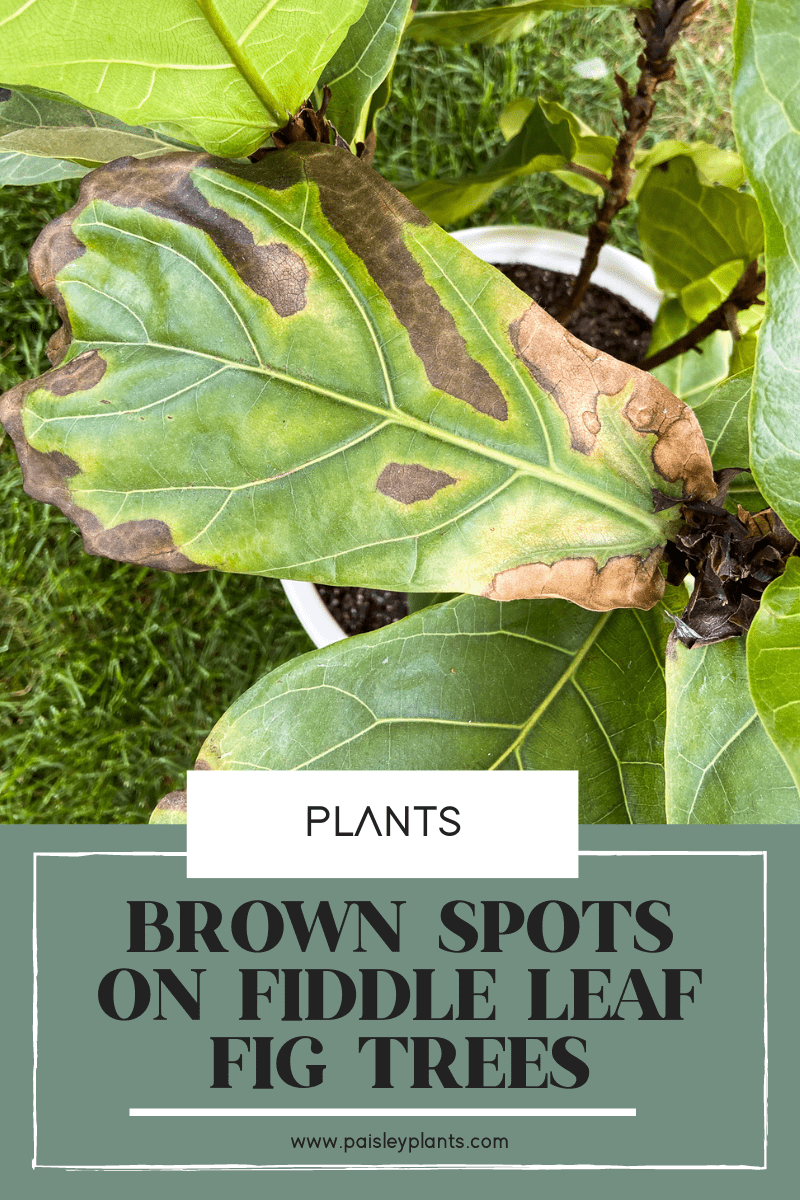
This post includes affiliate links.
Table of Contents
What Causes Brown Spots on Fiddle Leaf Fig Leaves?
That is quite the broad question; brown spots on a fiddle leaf fig can be caused by a number of reasons.
The five primary causes of brown spots on fiddle leaf figs are:
- Root Rot
- Bacterial Infection
- Pest Damage
- Under-Watering
- Sunburn
These spots can range in size, color, and texture; the ailment your fiddle leaf fig is suffering from is different depending on any combination of these characteristics.
While finding any brown spot on your fiddle leaf fig can be a scary thing to find, rest assured there are tons of ways to fix the issue.
How to Identify Brown Spots on Fiddle Leaf Figs & How to Fix It
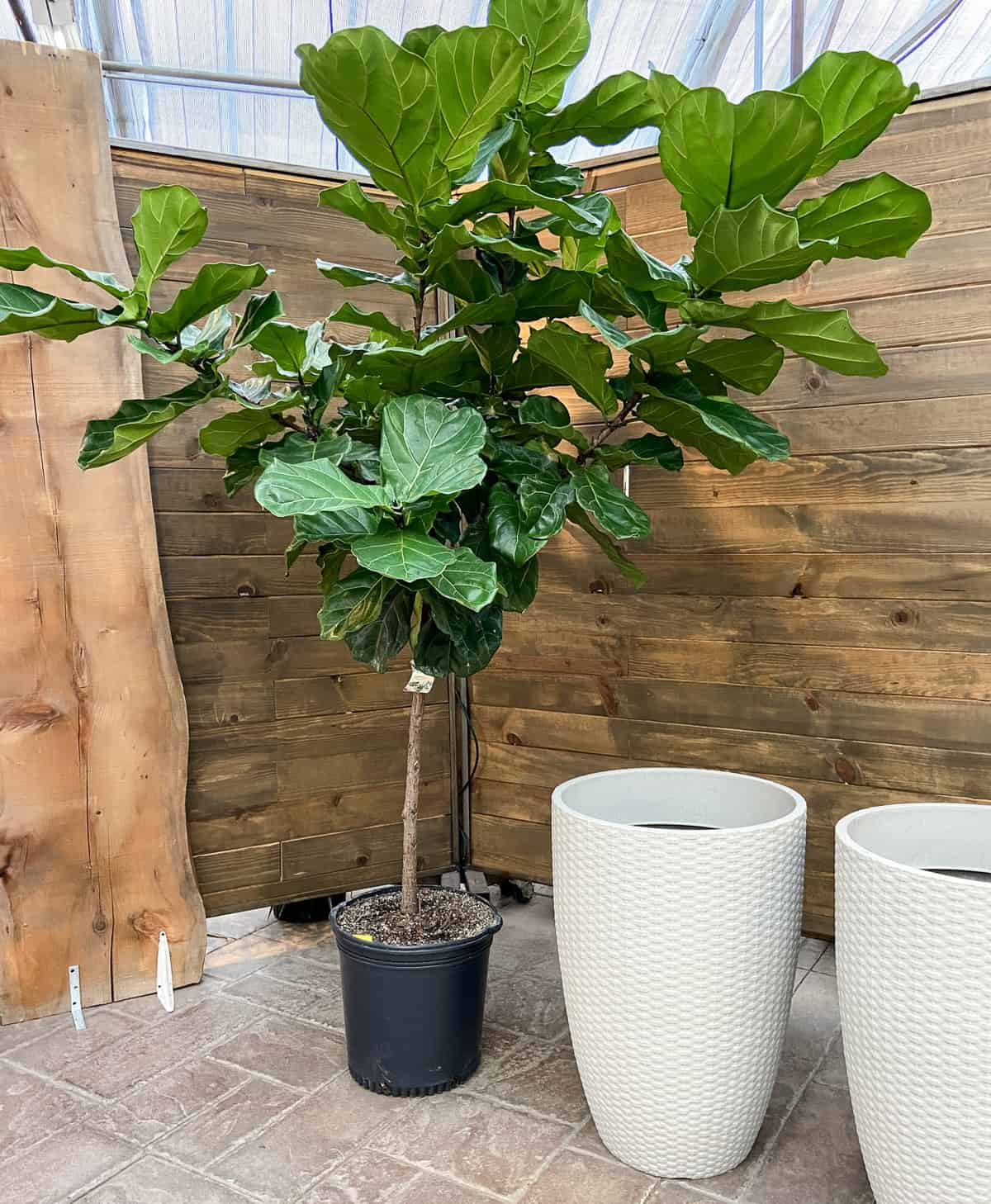
Finding brown spots on fiddle leaf fig can be surprising and nerve-racking. Let’s go over the five primary causes, how to identify each cause, and how to remedy fiddle leaf fig brown spots with these plant care tips.
Root Rot
Root rot is a very common (yet very deadly) disease in fiddle leaf figs that is the result of too much moisture combined with not enough drainage.
When all this moisture becomes trapped within the root system of your fiddle leaf, it could develop fungus, which then breaks down the roots.
Root rot manifests itself as large, dark brown splotches all over the leaves of the fiddle leaf fig. In addition to these large spots, the leaves of your plant may wilt and fall off. If left untreated, root rot can eventually kill your plants.
While it may be scary to discover root rot in your fiddle leaf fig, rest assured that there are treatment methods you can take in order to save your plants. Follow these plant care detailed instructions on how to remedy root rot on your fiddle leaf fig:
- Start by removing your plant from its pot. Do exercise extreme care as to not cause additional harm to your already fragile plant.
- Inspect the roots on the fiddle leaf figs very carefully. Rotted roots are mushy in texture and have a dark brown/nearly black color. In contrast, healthy roots are off-white on the plant and firm in texture.
- Using a sterilized, sharp pair of pruning shears, cut off any signs of rot that you find on your plant. Place these cuttings in a plastic bag and throw it away in order to prevent the spreading of disease.
- Clean out your plant pot and sterilize it; wiping the pot with rubbing alcohol can effectively sterilize and treat any residual signs of fungus on the fiddle leaf figs. Ensure that the drainage holes are unobstructed; if necessary, use a drill to create extra drainage holes for the soil.
- Repot your fiddle leaf in clean, fresh soil. Please ensure that this soil is well-draining (ideally a scoop of perlite is helpful in increasing the drainage of your plant’s soil).
- Prune any dry leaves on your plant that were damaged by the root rot. This will help encourage new, healthy plant growth and healthy vibrant leaves.
Moving forward, it is important to make sure that the soil for your plant is evenly moist, but never soggy or dry. Keep the soil at a consistent level of light moisture for the next couple weeks to prevent shock.
When the fiddle leaf has healed, you can return to normal watering. Keep in mind that fiddle leaf figs prefer the soil to dry out almost entirely before the next watering.
Bacterial Infection
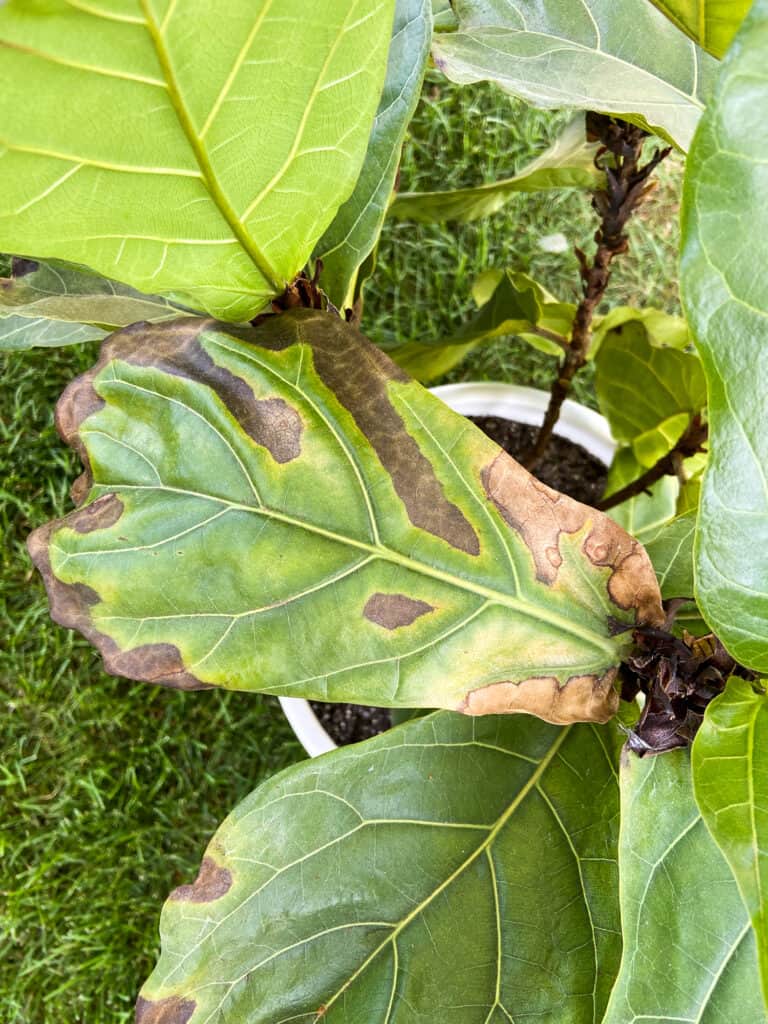
Bacterial infections can be a troublesome discovery on your fiddle leaf fig; they’re tedious to treat and can often become deadly when caught too late on a plant like this. A bacterial infection can manifest itself by light to dark brown splotches on the surface of the leaves.
In addition, the leaves usually wilt and/or fall off from the plant.
The key to treating a bacterial infection on your fiddle leaf figs is speed; act fast as soon as you recognize any signs of trouble to give your fiddle leaf fig the best chance. If you see a bacterial leaf spot may be harming your plant, here are some plant care tips to help treat it:
- Water your plant properly. Bacterial infections can be exacerbated by improper watering techniques in your fiddle leaf fig. Always keep in mind that fiddle leaf figs prefer to have their soil dry out almost completely before the soil gets re-watered.
- Give your plant a lot of sun. You should aim to give your plant at least 6 hours of bright, indirect sunlight.
- Prune any leaves that have been affected by the bacterial infection. This will help encourage new growth in your plants.
- Spray your plant with a bactericide. This may not be the most “natural” approach, but this is one of your last stands to treat a particularly severe bacterial infection.
- If the infection spreads to more than 50% of your fiddle leaf fig, it may be time to start over and dispose of the sick plant as it is no longer a quick fix.
- When disposing an ill plant, wrap it securely in plastic to prevent any disease from spreading near your current plant collection.
Fiddle Leaf Pests
While brown spots due to pests are a less common occurrence, they are still a possibility and should not be ruled out. The most obvious sign of pest and insect damage to your fiddle leaf is small dark brown spots followed by a hole where the spots were.
Examples of common pests that may attack your fiddle leaf are spider mites and scale. Spider mites are small arachnid creatures that are usually white in color. Scale is also small, yet tends to be tan or brown.
Both of these pests like to latch onto the leaves of the plant and suck out the nutrients causing the leaves to turn brown, and making the plant fig plant food.
The first key to preventing damage from these insects on your fiddle leaf fig is to maintain an overall healthy plant and healthy leaves. Pests are most likely to attack a plant when it is unhealthy and has brown spots on its leaves.
In addition, we recommend doing weekly wellness checks on your plants to look for any obvious signs of pest damage. Pests are prone to attack the fiddle leaf fig when it’s in its most vulnerable condition.
If you do have an unfortunate encounter with any of these pests – don’t fret! These pests are possible to be controlled with simple, natural methods.
Always prune any leaves on your plant that have been damaged by pests.
One of the best gifts you can give your plant is removing these brown leaves on your fiddle leaf figs, your plant will redirect its energy towards developing new, healthy growth, as opposed to trying to revive a diseased leaf on your fiddle leaf fig.
When working with the fiddle leaf fig, many gardeners use a natural horticultural oil, such as neem oil. Neem oil is one of the best natural pesticides that can be found at many garden retailers or online.
Spray your affected plant with neem oil and wipe down the leaves. This process usually has to be repeated a few times in order for a total extermination of pests on the fiddle leaf fig.
You can also use common household items in order to attack your pests. Combine two tablespoons of dish soap with one gallon of water. Pour this mixture into a spray bottle and spray down your plants and leaves.
Once again, this process will need to be repeated 2 to 3 times in order to successfully get rid of your pest problem on your fiddle leaf figs and its leaves.
Underwatering a Fiddle Leaf Fig Plant
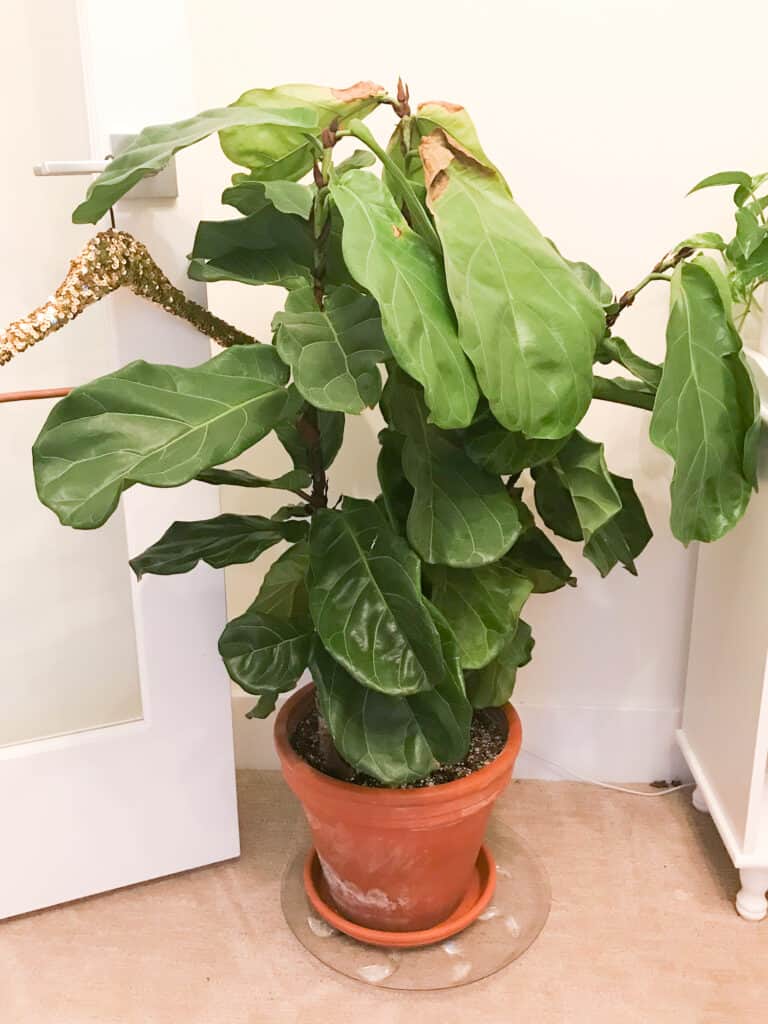
Underwatering, or dryness, manifests itself as tan and brown crunchy spots on your fiddle leaf fig. These brown spots start at the edge of the leave before traveling towards the center.
In addition to these tan spots, the leaves may curl up and/or wilt on your houseplant.
As we’ve discussed previously, the fiddle leaf fig plant prefers their soil to dry out in between waterings, but it is important to water your plant on a normal schedule to avoid underwatering your plant especially during the hot summer months.
Use our water tracker if you need help getting your plant on a good watering schedule.
I also use one of these water detectors to keep me in check too. It’s made a huge difference in knowing if my plants need water or not.
In addition, humidity levels in the air also contribute to the dryness and brown spots on your plant. As a tropical plant, your fiddle leaf fig enjoys a humidity air level of roughly 50% humidity.
The crisp air helps keep your plants leaves looking their glossy and vibrant fiddle leaf fig best, instead of dry, brown, and crunchy.
Sunburn On Fiddle Leaf Fig Leaves
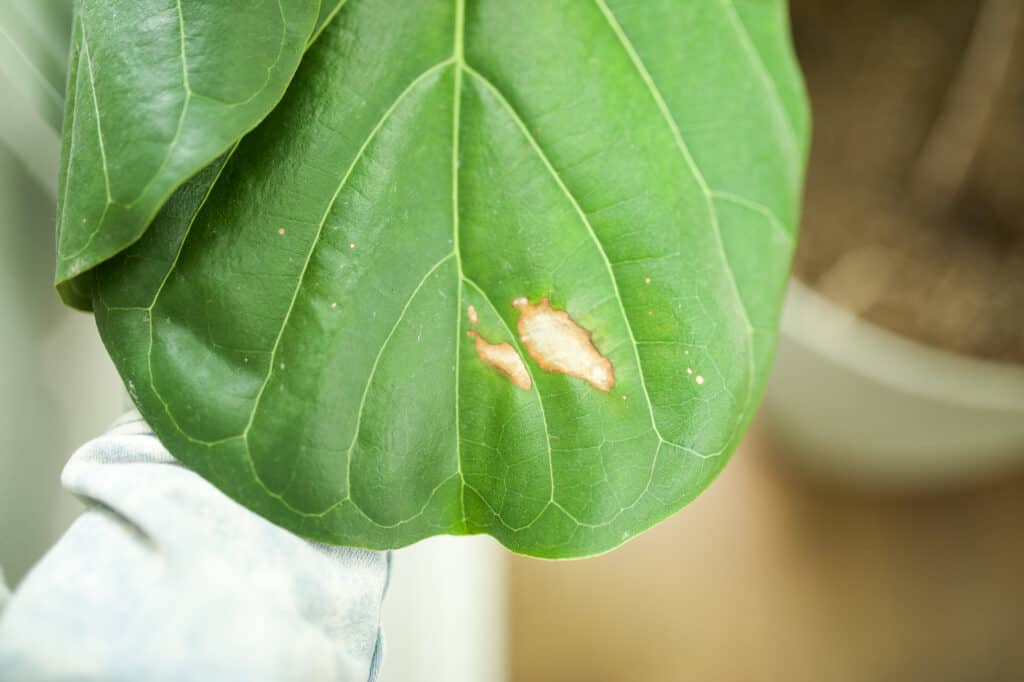
If your fiddle leaf fig leaves have crunchy light brown spots on the leaves, this can be a sign on sunburn damage. Most houseplants do best from bright, indirect light, and the fiddle leaf fig is no exception to this.
Exposure to direct sun is a recipe for disaster when it comes to your fiddle leaf fig leaves which causes their gorgeous green leaves to have large brown spots.
In order to avoid sunburns on your plant, be sure to provide your fiddle leaf fig with bright, indirect sunlight. Refrain from placing your fiddle leaf fig in a location near direct light especially during those hot summer months.
If you choose to keep your fiddle leaf fig in an outdoor setting (such as a front porch or balcony), then we highly recommend turning it and keeping it near a partially shady location with low light conditions to avoid it getting dry leaves with brown spots on the fiddle leaf fig.
FAQ
Remove the affected leaves and make sure your plant has adequate light. If there are multiple brown spots, you’ll need to cut away any brown, mushy roots and the leaves with brown spots then repot your plant, taking care not to over water in the future.
Rust is a fungal growth that is rarely found in dry climates. The first signs of fig rust on fruit trees are tiny yellow spots on the underside of leaves. The rust on fig leaves’ underside then spreads to the upper portion, and the spots become reddish brown. Home gardeners often miss early signs of the fig’s disease.
In Conclusion
No plant owner wants to wake up to find brown spots on their beloved plant, but that is an unfortunate reality for many plant parents especially fiddle leaf fig owners.
Luckily, there are tons of options plant owners can take in order to identify and troubleshoot the issues to keep their plant looking happy and healthy for years to come!
Looking for more Fiddle Leaf fun? Head over to one of these posts!

